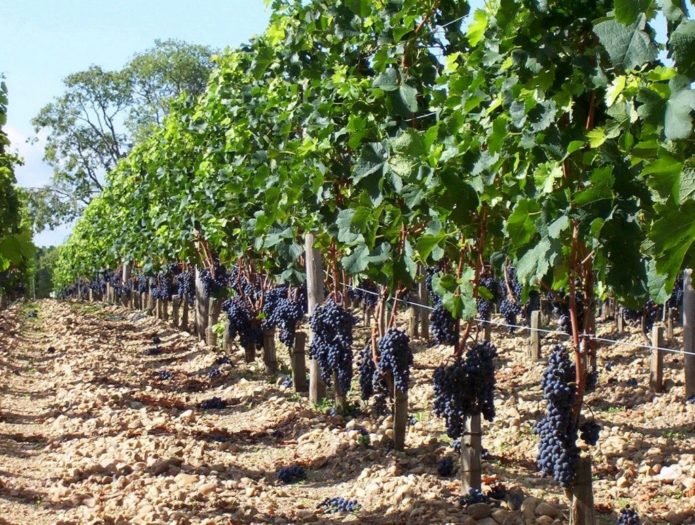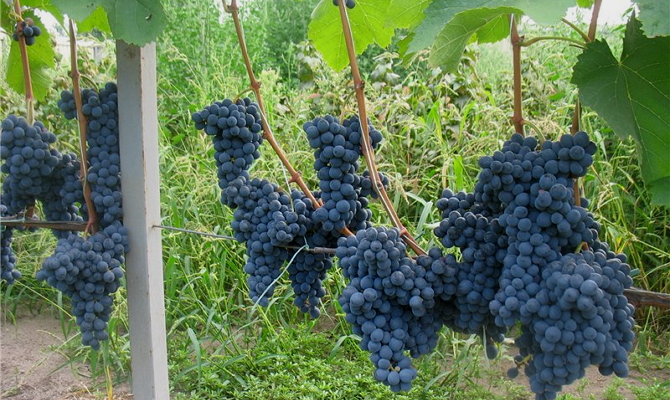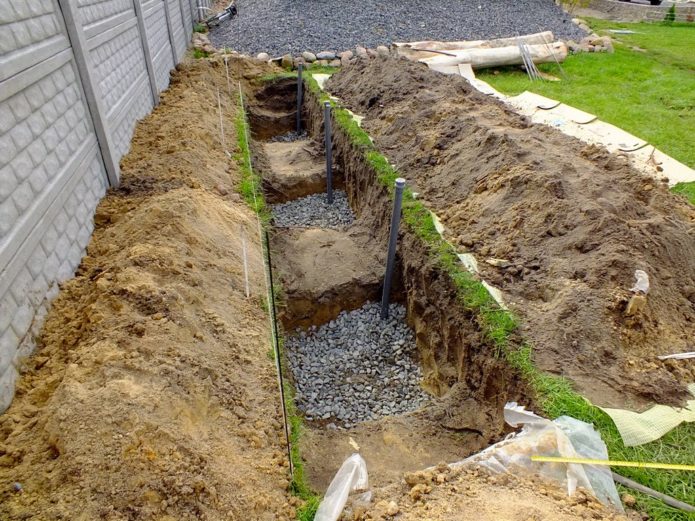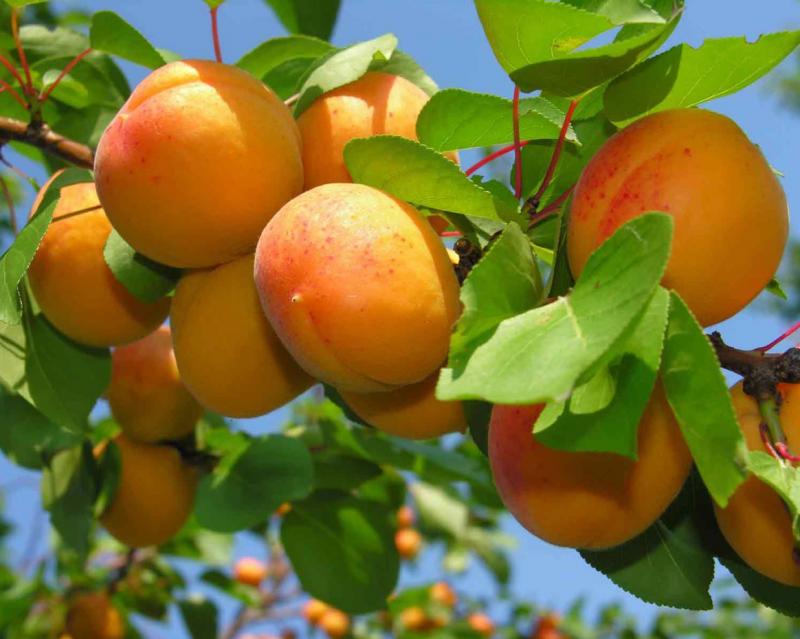North Saperavi is one of the best dark-colored technical grape varieties grown for more than half a century. An excellent dessert wine is obtained from Saperavi, as well as several varieties of fortified wines. Unlike many other technical varieties, the berries of this grape are quite suitable for fresh consumption. Its cultivation is not particularly difficult.
Content
Breeding history, description and characteristics of the Saperavi northern grape variety
Northern Saperavi is a domestic grape variety, it was bred in 1947 at the V.N. Ya. I. Potapenko (Novocherkassk) based on Saperavi and Severny varieties. An application to the State Register of the Russian Federation for admission to widespread use was submitted by breeders back in 1957, from the next year the variety was on state variety trials. In 1965, Northern Saperavi received its rightful place in the register with an entry on the recommendation of its use in the North Caucasus and Lower Volga regions..
This grape is widespread in the south of our country and in Ukraine, as well as in the Transcaucasian republics, Kazakhstan and even in Central Asia, but it is often found in private vineyards in central Russia.
The highest density of its Saperavi northern plantings is recorded in the Black Sea regions. In not the hottest regions, high-quality table wines are made from it, and on the southern coast of Crimea or in Uzbekistan, it matures so much that it is suitable for the production of dessert and strong wines.
Saperavi bushes are of medium vigor and are characterized by good maturation of the vine. Ripe young shoots are brown, the leaves are below average size, slightly dissected, of the usual green color, slightly pubescent below. Shoot tips are light green, pubescent. In the fall, the foliage turns wine red.
The cultivar has increased resistance to mildew and gray rot, but resistance to bunchy leafworm is at an average level. Unstable to oidium. The drought resistance of the variety is low: with a lack of moisture, the berries can wither and crumble.
Vineyard disease and pest control:https://flowers.bigbadmole.com/en/yagody/vinograd/obrabotka-vinograda-ot-bolezney-i-vrediteley-sroki-obrabotki.html
Frost resistance in the years when the variety appeared was considered very high, and even now it is slightly higher than that of most modern varieties: vines without shelter tolerate temperatures down to -27 aboutFROM. However, the buds bloom very early, as a result of which they can fall under spring frosts. True, grapes are capable of producing fruitful shoots from replacement buds. Compatible with most zoned rootstocks.
The yield is very high, annual. Bunches originate in about 80% of shoots, 1.6–1.8 bunches per one fruitful shoot. The flowers are bisexual, pollinators are not required for the variety. Severnyi Saperavi belongs to the medium-late ripening varieties, from bud break to harvest ripening 140-145 days pass.Berries are picked in the second half of September. The crop must be harvested in a timely manner: being late leads to significant shedding of the berries.
Bunches are conical in shape, weighing a little over 100 g, the packing of berries is medium-sized. Peas are insignificant. The ridges make up about 3% of the total mass of the bunch. Berries from small to medium size, weighing no more than 2 g, oval. They are dark blue in color, covered with a waxy coating, and may contain from 3 to 5 seeds. The berry is covered with a dense skin, which protects the juicy pulp with an ordinary, but harmonious taste from damage.
More than 8 liters of thick dark pink juice are obtained from 10 kg of berries. Sugar content in different years ranges from 20 to 25%, acidity from 9 to 11 g / l. However, it is not only the reasonable combination of sugar and acid that makes Saperavi suitable for the production of a variety of wines, including sparkling ones. The juice contains more than three hundred different organic substances that make up the taste and aroma of this grape.
Serious research, carried out back in the 1980s, showed that this particular variety is the champion in the amount of aromatic substances, which makes it possible to make amazing wines from it.
However, wines made from individual juice, according to tasters, often have excessive astringency, so it is believed that Saperavi manifests itself even better in blended wines, and, by the way, in juices too. When eating grapes, it should be borne in mind that berries, including the skin, contain very strong dyes, which instantly gives an imprint on the lips and even on the teeth. A similar picture emerges when tasting the juice and wine from this grape.
Features and conditions for growing grape varieties for wine production:https://flowers.bigbadmole.com/en/yagody/vinograd/sorta-vinograda-dlya-vina.html
Video: about homemade wine from Saperavi
Features of planting and cultivation of the Saperavi North grape variety
Northern Saperavi cannot be called a non-capricious variety, and this must be taken into account both during planting and during the subsequent care of the bushes. The grapes are planted only in areas with the possibility of good watering, always illuminated by the sun and protected from cold winds. If more than one bush is planted (and for technical varieties this is almost always the case), the optimal placement scheme is 2.5 x 1.5 m.
The nature of the soil does not matter much, but it is important that it does not become waterlogged, therefore drainage is required when planting. Acidic soils are also unsuitable; in extreme cases, they should be corrected in advance by introducing a sufficient amount of lime or chalk. Light loamy, loamy, sandy loamy soils, as well as chernozems are optimal. In all these variants, the roots are provided with an easy access of oxygen and moisture, light soils allow the roots to penetrate into deeper layers.
Saperavi is mainly cultivated in the southern regions, where the soil does not freeze in winter, and grapes can be planted there from October to March. Growing grapes in the middle lane it is advisable to plant it in April, but planting holes are prepared in the fall. For planting several bushes, it is more convenient to dig a common trench with a depth and width of at least 80 cm: the root system develops rather quickly and grows to a size of 2–3 m, spreading both inland and in all directions.
A layer of drainage material must be introduced into the pit (trench), on top of which a layer of fertilizers mixed with the soil is laid. Approximately 2-3 buckets of humus, 250 g of superphosphate, 30 g of ammonium nitrate and 100-150 g of any potassium fertilizer are added to one bush, which can be successfully replaced with a liter jar of wood ash. Above, there should be a layer of clean fertile soil, in which, in fact, the grapes are planted so that the young roots do not touch the fertilizers.
The planting process itself has no peculiarities.1-2 buds are brought to the surface, the seedling is thoroughly watered, the soil around it is mulched. In the first year, frequent watering is needed, and in the subsequent Saperavi needs increased doses of moisture. Especially it is necessary to monitor soil moisture in the first half of summer, during the intensive regrowth of young shoots and berry filling.
Video: planting and growing technical grape varieties
Top dressing for these grapes is necessary in the same doses as for most other varieties: they should not be carried away, especially with regard to nitrogen-containing fertilizers. In the spring, every two years, a bucket of humus is buried under the bush, and annually - 1-2 liters of ash. Before flowering, the bushes are fed with nitrophosphate (15 g per bucket of water), and in the middle of summer with a solution containing 10-15 g of superphosphate and potassium sulfate per bucket.
The correct formation of the bush and the garter of the shoots are of great importance. In the year of planting, any peg is suitable as a support, but then a trellis is required. For Saperavi, three horizontal rows of wire are enough, stretched every 40–50 cm. Both a dry garter (before bud break) and a green garter, performed throughout the summer as the shoots grow, are carried out.

In industrial vineyards, a long trellis is made and the bushes are shaped so that it is convenient to tie them up
The main pruning can be carried out both in autumn, after leaf fall, and in early spring, long before the start of sap flow. This variety is grown with equal success both in a standard-free culture and with a low-standard bush formation. The standard-free version means the formation of a multi-arm fan: in this case, the shoots are cut into 6 eyes with a full load on the bush of no more than 35 buds. At the same time, the bushes are rejuvenated annually, cutting out a certain amount of perennial wood.
With a low-standard fan-shaped formation, it is possible to load up to 60 buds on the bush with cutting each shoot to 8-10 eyes. To do this, by autumn, the most developed shoot is selected from a young plant and the rest are removed. The left shoot is shortened to the height of the future trunk (in fact, the trunk, if we draw an analogy with a tree). It is important that 2-3 well-developed eyes remain in its upper part. A year later, shoots develop from them, from which they form perennial branches.
In the process of growing grapes, they do not forget about green operations, which are carried out throughout the summer, removing excess young shoots and pinching those that grow too much. The harvest is also normalized, leaving no more than 5-6 bunches for the shoot. Leaves growing too close to the bunches and interfering with their airing are cut off. Leave the leaves that cover the berries from the too hot sun.
It is advisable to carry out all operations for pruning even green shoots with a sharp pruner; ripe bunches are also cut off.
The variety cannot be considered disease-resistant, therefore preventive spraying must be carried out. In ordinary years, it is enough to double the treatment per season with ordinary fungicides: in early spring with a solution of ferrous sulfate and during the growing season, but long before flowering - with Bordeaux liquid. In regions with widespread phylloxera, it is necessary to use spraying with various insecticides.
Saperavi needs a light cover for the bushes for the winter. In the southern regions, only young bushes are sheltered, in the middle lane - and fruiting, and therefore the standard formation is possible only in the south. The shelter is made of non-woven materials or thrown onto the spruce branches of coniferous trees removed from the vines.
Correct planting of grapes is the key to a good harvest:https://flowers.bigbadmole.com/en/yagody/vinograd/kak-posadit-vinograd.html
Video: about Saperavi North, which survived frosts
Advantages and disadvantages of the variety in comparison with similar
There are not many good technical grape varieties with dark blue berries. Basically, breeders are working on table varieties, which is why it turns out that grapes of "retirement age" are still in service.Northern Saperavi is less frost-hardy than the well-known Isabella grape variety, it cannot be grown without cover in the middle lane. But the quality of the harvest is significantly higher: the berries can be eaten fresh, and not just used for juice and wine.
There are technical varieties with simpler agricultural techniques and larger berries. But if you compare Saperavi, for example, with Cabernet Sauvignon or Black Pearl varieties, it turns out that the comparison is not very correct. Each variety is good in its own way. The most important advantage of Northern Saperavi over similar varieties is, perhaps, a unique bouquet due to the most complex chemical composition of its berries.
The main advantages of the variety, in addition to being useful for making fine wines, are:
- high annual yield;
- good frost resistance;
- buncation of flowers;
- excellent portability;
- increased resistance to mildew.
The disadvantages are:
- strong susceptibility to powdery mildew;
- shedding of flowers and ovaries.
Variety reviews
For the first time, with a small harvest, he made wine from C / S. It turned out seven liters, did not alcohol. I poured it a third time from the sediment, the wine did not clarify. It turned out to be dark, rich and thick. The taste is very peculiar, with a touch of chocolate, slightly overestimates the acidity.
This year made the North Cahors from Saperavi. First, I separated and mashed the berries, then heated up to 70 degrees. Because it was a test, then I did not use the press, I squeezed it out with my hands in a colander. Received a wort of 25% sugar. Added 70% wine alcohol at the rate of 3 parts of wort: 1 part of alcohol. I tried it, it turned out something like a liqueur. I tried it a month later. All the pulp settled, the wine became transparent, aromatic and very tasty.
My S.S. is growing for the 5th year. Not the earliest, not the sweetest ... but the all-around champion in his category. After the cataclysms of this year, it came out with the least losses. In addition, it is frost-resistant - I hardly cover it.
North Saperavi was the first of the techies on the site. The first selective cut on September 11 was used to make a yeast starter. The main crop was cut on September 17, it grows slowly, but I like the potential, on average 6 kg were obtained from the bush, all went into the sepage with dye. The largest bunch was 0.6 kg. Not rationed, the vine ripened well. 4th year of vegetation.
I have had it since 2002, then I got the first seedling from my teacher Anatoly Kirillovich Pavlenko. More than ten years have passed, and parting with S.S. I do not plan. It suited me.
North Saperavi grapes have been cultivated for a very long time, but they remain one of the best varieties for making excellent red wines. Most of these grapes are grown in the south, but in small private vineyards, they can also be found in the central region, since the variety has a high frost resistance. With the development of the breeding business, Saperavi, perhaps, will go down in history, but so far his position among winegrowers is quite strong.





1 comment